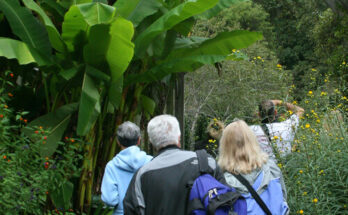Alliums are among the best-kept secrets in gardening, despite being members of the popular Amaryllidaceae family. The genus is known for its garlic, onions, and chives, yet most species are actually ornamentals of surprising beauty.
One perennial allium, in particular, Allium hollandicum’ Purple Sensation’ (AL-ee-um hol-LAN-dee-kum), is a real show-stopper. In this article we will look at growing Purple Sensation Allium.
The parent species hails from Iran, and it’s suspected this particular cultivar was originally part of a selection by J. Biji in 1963, although this has yet to be confirmed.
Over the years, growers have repeatedly identified this plant as either A. aflatunense’ Purple Sensation’ or A. ×hollandicum ‘Purple Sensation’ (indicating a hybrid).
However, ‘Purple Sensation’ is not related to A. aflatunense, a completely different species from hollandicum.
This plant is best known by the common nickname of ornamental onion, although it does share its parent’s nicknames of Persian onion and Dutch garlic.
Allium ‘Purple Sensation’ Care
Size And Growth
‘Purple Sensation’ is a medium-sized allium, reaching between 2′ and 3’ feet tall at maturity and spreading up to 2’ feet across.
The clumps feature long, blue-green straplike leaves that can grow as long as 24” inches each.
However, this plant’s true draw comes in late spring.
Flowering And Fragrance
Between May and June, tall stalks measuring as tall as 36” inches springs up and blooms into umbels.
Each of these umbels is around 4” inches in diameter and is made from dozens of tiny, star-shaped flowers boasting rich purple to reddish-purple hues.
These long-lasting flowers will dry out long before they lose their color, providing a wonderful display that lasts into the fall.
Light And Temperature
Alliums love their sunlight and do best when given full sun for at least 6 hours per day.
In harsher southern climates, it’s best to restrict the plant to an eastern or western exposure, so it has some shade in the middle of the day.
Alliums can tolerate light shade, which will stunt their growth and can make their flower stalks weaker.
These plants are very sensitive to high moisture and should be kept in lower humidity to prevent fungal infections.
Despite this, they can handle low temperatures and will often survive the winter when mulched.
However, it’s best to uproot the bulbs and take them indoors if you expect a cold winter, which is a perfect excuse to propagate them.
You can grow them outdoors in USDA hardiness zones 4 to 8.
Note that while the stalks are relatively sturdy, this plant doesn’t like sudden, strong winds once it blooms and may suffer damage.
Watering And Feeding
As with most plants, Allium hollandicum’ Purple Sensation’ should be watered using the soak-and-dry method.
Stick your finger straight into the soil and water if it feels dry, about 1″ to 2″ inches down.
Pour slowly and evenly so the soil can soak the water up as fast as you’re pouring, and slowly work your way around the base.
Avoid getting the foliage wet as you go, and stop watering when you notice the ground can no longer absorb as fast as you pour.
For potted plants, you can use this same signal or stop when you see moisture beginning to seep from the drainage holes.
Because ‘Purple Sensation’ can adapt to even the poorest soils, you don’t need fertilizer.
However, if you’re transplanting a bulb in early spring, you can mix some organic compost into the soil before planting.
Soil And Transplanting
Alliums can grow in almost any type of soil as long as it’s well-draining.
This includes a fairly wide pH range of 6.0 to 8.0, allowing it to grow in most garden spaces.
However, while it can handle a wide range of soils, it does best in slightly sandy, rich soil.
You’ll want to uproot the bulb and overwinter it indoors in colder climates.
Potted specimens will need repotted every 2 to 3 years to replace the soil, at which point they can be divided to prevent root binding.
Grooming And Maintenance
These plants can take care of themselves, and it’s best to let the foliage die back on its own so the bulb can save as much energy as possible for the winter months.
How To Propagate ‘Purple Sensation’ Allium?
As with all alliums, you can easily propagate ‘Purple Sensation’ through bulb division.
Note that while you could theoretically propagate the plant through its seeds, you are far more likely to end up with the parent plant as a result.
Ornamental Onion Pests Or Diseases
Alliums are toxic to most animals, making deer and rabbits avoid them.
Just be warned, this plant is also toxic to cats, dogs, and horses.
While non-toxic to humans, it’s not considered an edible variety due to the high concentration of sulfates, which can lead to indigestion and some temporary gastrointestinal issues.
It’s also tolerant of drought and resistant to most pests and diseases. However, be wary of white onion flies and the risk of fungal infections or root rot due to excess moisture.
Allium ‘Purple Sensation’ Uses
This cultivar has earned the Royal Horticultural Society’s Award of Garden Merit.
It looks excellent along borders or as a container plant.
The blocks are full of nectar and draw pollinators such as bees and butterflies.
This plant is perfect for cut flowers because they retain their color even after drying out.
One important note regarding ‘Purple Sensation,’ however, while alliums are known to repel a wide range of insect pests, such as aphids, mealybugs, and various caterpillars, there is no hard data on this cultivar’s effectiveness.
It is likely that ‘Purple Sensation’ will have the same effectiveness as its parent, although you should use caution when companion planting to be safe.
That said, if you aren’t using this as a repellent plant, it still draws pollinators and adds a lovely touch to most garden settings, making it well worth mixing in.
More On Growing Alliums
Source link
Originally posted 2022-10-20 18:53:23.





